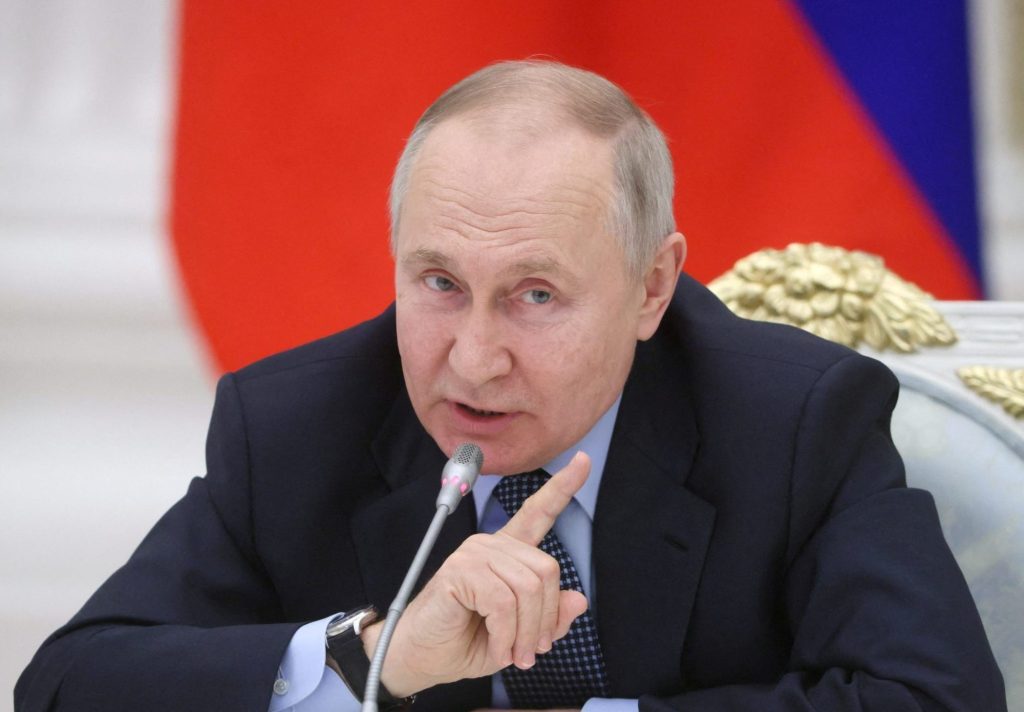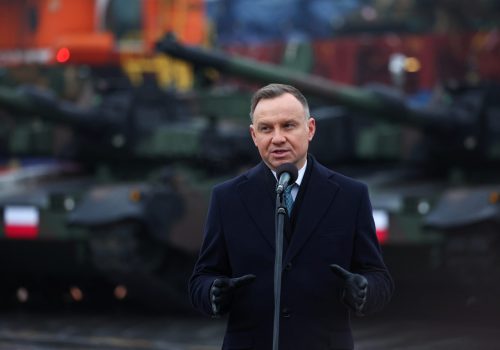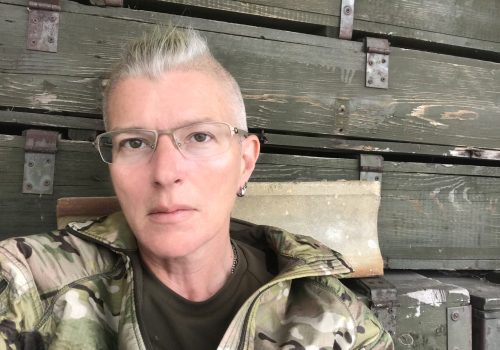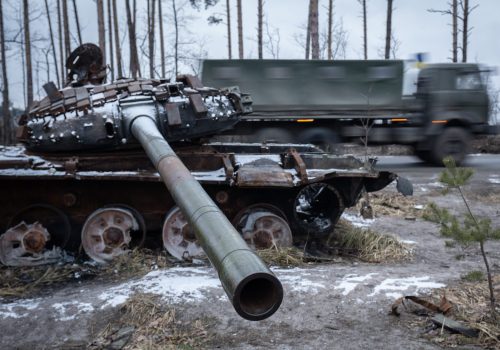As Russia’s invasion of Ukraine approaches the one-year mark, the Western response is still being undermined by exaggerated fears of escalation and misplaced concerns over the dangers of “provoking Putin.” But while Western leaders and commentators continue to warn of dire consequences if Ukraine dares to resist, the experience of the past twelve months tells a very different story.
Since the invasion began, Ukraine has repeatedly defied the Kremlin and ignored Russia’s red lines. On each occasion, Moscow has failed to make good on its bloodcurdling threats and has instead retreated to new red lines. It should now be clear to any rational observer that in reality, Putin’s red lines are nothing less than a roadmap to Russian defeat in Ukraine.
Russia has a long history of imposing imaginary red lines on Ukraine and the West. Many years before Russia’s attack on Ukraine began with the 2014 seizure of Crimea, Kremlin leaders were warning their Western counterparts that Ukraine as a whole was a red line. Following the onset of open Russian aggression against Ukraine nine years ago, Moscow then claimed that any form of military aid to Kyiv was a red line for Russia.
Over the past year or so, we have seen successive red lines drawn over the delivery to Ukraine of anti-tank weapons, artillery, air defense systems, and tanks. All of these red lines have been crossed without provoking the threatened Russian response. It is entirely reasonable to assume that the most recently announced Russian red line over the delivery of fighter jets to Ukraine will prove equally ineffective.
Likewise, Russian attempts to impose red lines over the liberation of occupied Ukrainian land have repeatedly been exposed as toothless. In September 2022, Vladimir Putin oversaw a grandiose ceremony in the Kremlin announcing the illegal annexation of four partially occupied Ukrainian provinces. These regions had joined Russia “forever,” the Russian dictator declared. However, when the advancing Ukrainian military freed Kherson within weeks of Putin’s proclamation, Russian forces simply retreated.
Stay updated
As the world watches the Russian invasion of Ukraine unfold, UkraineAlert delivers the best Atlantic Council expert insight and analysis on Ukraine twice a week directly to your inbox.
Russia’s relentless talk of red lines is central to the Kremlin’s intimidation tactics. Putin is well aware that while Western leaders staunchly oppose his imperial aggression against Ukraine, Western electorates have no stomach for an actual war of their own against Russia. By hinting at catastrophic costs, he aims to undermine Western resolve. This reflects his belief that the West is fundamentally weak and unprepared to accept any significant risks on behalf of the values at stake in Ukraine.
Behind all of Russia’s red lines looms the threat of a nuclear response. On numerous occasions during the past year, Putin has resorted to thinly veiled nuclear blackmail in a bid to scare the West into abandoning its support for Ukraine. Perhaps the most infamous example came during a September 20 address in which Putin indicated his readiness to use nuclear weapons before warning: “I’m not bluffing.” Unfortunately for Putin, Ukraine has repeatedly called his bluff without sparking a nuclear response.
Putin’s nuclear saber-rattling rings hollow for a number of reasons. The military argument is far from conclusive, with many analysts noting that nuclear weapons would not decisively turn the tide in Moscow’s favor. Crucially, deploying nukes in Ukraine would be absolutely disastrous for Russia’s global standing and would leave the country completely isolated. The United States has both publicly and privately explained to Moscow that the use of nuclear weapons would have “catastrophic consequences” for Russia. Meanwhile, even Russia’s Chinese partners have condemned Putin’s nuclear threats.
Eurasia Center events

As the world marks the first anniversary of Putin’s criminal invasion, it is time to learn the lessons of recent history and recognize that nothing is more likely to provoke further Russian aggression than continued Western hesitancy. The cautious Western response to Russia’s 2008 invasion of Georgia paved the way for the 2014 seizure of Ukraine’s Crimean peninsula. The weak reaction to Crimea then encouraged Russia to start a war in eastern Ukraine. Failure to punish Russia for that unprecedented act of international aggression convinced Putin that he could get away with the full-scale invasion of February 2022. If Putin is not stopped now in Ukraine, he will inevitably go further.
Russian threats should not be taken lightly, of course. In addition to its vast nuclear arsenal, Moscow has huge conventional military capabilities and has also proven itself adept at hybrid forms of international aggression. Nevertheless, the experience of the past year has demonstrated convincingly that so-called Russian red lines in Ukraine can be safely crossed without triggering World War III. Indeed, these red lines actually reveal Russia’s own weaknesses and serve as signposts for Western policymakers looking to identify how best to secure a Ukrainian victory.
The real danger lies in allowing Russia’s intimidation efforts to succeed. If the West remains too afraid of Putin to stop Russia in Ukraine, the consequences for international security will be grave. Russia will be emboldened and will expand its international aggression, with likely initial targets including Moldova, Kazakhstan, and potentially the NATO member Baltic states. Other authoritarian regimes will take note of Russia’s success and will employ similar tactics. Nuclear blackmail will become an increasingly prominent foreign policy tool, leading to an arms race as dozens of threatened nations scramble to acquire nuclear weapons of their own.
The only way to prevent the world from descending into a dangerous new era of instability is by confronting Russia decisively in Ukraine. This will require considerable political courage on the part of Ukraine’s Western partners. Western leaders must overcome their fear of escalation and provide Ukraine with the tools to stop Putin. The Russian dictator has demonstrated time and again that he only understands the language of strength and will back down when confronted. This confrontation can no longer be avoided. The longer the West waits, the higher the price will become of stopping Putin.
Oleksiy Goncharenko is a Ukrainian member of parliament with the European Solidarity party.
Further reading
The views expressed in UkraineAlert are solely those of the authors and do not necessarily reflect the views of the Atlantic Council, its staff, or its supporters.

The Eurasia Center’s mission is to enhance transatlantic cooperation in promoting stability, democratic values and prosperity in Eurasia, from Eastern Europe and Turkey in the West to the Caucasus, Russia and Central Asia in the East.
Follow us on social media
and support our work
Image: Russian President Vladimir Putin meets with representatives of the professional aviation community on the 100th anniversary of domestic civil aviation, in Moscow, Russia. February 9, 2023. (Sputnik/Mikhail Metzel/Pool via REUTERS)




